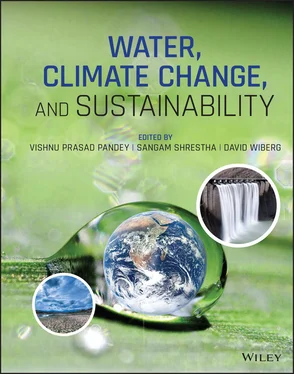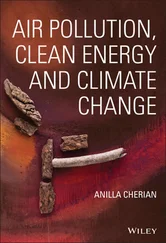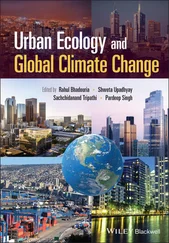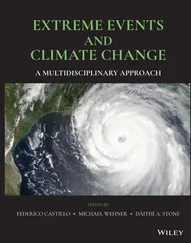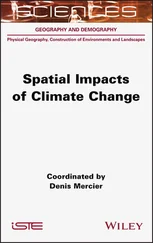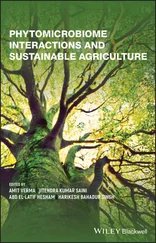3.2.2. Water Use in Biomass Production
Water required to produce fossil fuel is low (1 m 3/GJ), compared to the large quantities of water needed to produce biofuels (24 ‐ 146 m 3/GJ) (Gerbens‐Leenes et al., 2008). In biofuel production process, biomass production uses large quantities of freshwater. In areas with enough rainfall, crops are mainly rainfed; however, irrigation supplements the insufficient supply of water due to low rainfall in dry regions. Irrigation is required at different stages of plant growth, and lack of water at the key growth stages can significantly affect the crop yield.
Crop water demand depends on the evapotranspiration (ET) rate, which is the process of evaporation of water from the soil and transpiration from plants (Schwalbe, 2017). ET is affected by the environmental conditions, such as precipitation, soil moisture, temperature, tillage practices, crop rotation practices, cover crops, types of fertilizers used, and irrigation scheduling. Only ~5% of the water received by the plant is utilized to perform biochemical reactions, transport nutrients, and maintain turgidity, and the remaining is lost through ET (Langeveld and van de Ven, 2010). Of the total water received by the plant, 0.2% to 0.4% actually contribute to the plant dry matter (Condon et al., 2004). For the purpose of sustainable development of bioenergy systems, development of bioenergy crops with low ET is more desirable. ET and water footprint of some crops, including starch, lignocellulosic, and oil containing crops, which can be used for bioenergy purposes, are presented in Table 3.1.
Bioethanol is the main biofuel produced worldwide. The two largest crops for ethanol production are corn in the US and sugarcane in Brazil. Most of the US corn is produced under rainfed conditions; however, in areas where it is irrigated, water is mainly supplied from groundwater sources, such as the Ogallala Aquifer which supplies irrigation water for ~45 million ha of land in eight states of the US (Maupin and Barber, 2005). Sugarcane is a perennial crop, with high concentration of sugar juices, which is mostly produced under rainfed conditions (Moreira, 2007). Irrigation is becoming necessary as sugarcane production is expanding to arid areas (Goldemberg et al., 2008). Irrigation needed for most of the crops grown for food, except corn, is higher than that for dedicated energy crops, such as switchgrass, miscanthus, willow, poplar, and eucalyptus (Fraiture and Berndes, 2009). Corn production in the US needs low quantities of water, because it is grown in areas with enough rainfall (Le et al., 2011; VanLoocke et al., 2012; Wu and Liu, 2012). Other types of biomass used for energy production, such as sewage sludge and manure, have little to no water requirements in the production phase. Sewage sludge and manure can be used as by‐product of the systems for bioenergy generation purposes without additional water requirement for the production phase. Algae production systems need a large quantity of water, however, in a closed system where most of the water is recycled, the water footprint is between 1.4 – 5.8 m 3/kg of dry algal biomass produced (Martins et al., 2018).
Table 3.1 Evapotranspiration and water footprint of some crops for energy purposes.
| Feedstock |
ETm 3/GJ feedstock * |
Water footprintm 3/kg feedstock * |
Reference |
| Sugarcane |
18–124 |
0.12–0.59 |
Berndes, 2002; Fraiture and Berndes, 2009 |
| Sugar beet |
48–151 |
0.11–1.11 |
Berndes, 2002; Fraiture and Berndes, 2009 |
| Corn |
37–190 |
0.48–1.43 |
Berndes, 2002; Fraiture and Berndes, 2009; Postel, 1998 |
| Wheat |
21–199 |
0.28–1.67 |
Berndes, 2002; Fraiture and Berndes, 2009; Postel, 1998 |
| Sweet sorghum |
|
0.18 |
Bennett and Anex, 2008 |
| Grain sorghum |
|
2.67 |
Critchley et al., 1991 |
| Cassava |
|
0.55 |
Liu et al., 2007 |
| Sweet potato |
|
0.23 |
Liu et al., 2007 |
| Rapeseed |
46–81 |
0.83–2.2 |
Berndes, 2002 |
| Oil palm |
|
3.2 |
Berndes, 2002 |
| Soybean |
|
1.43–2.5 |
Postel, 1998 |
| Canola |
|
1.8 |
Bauder, 2019 |
| Lignocellulosic crops |
7–68 |
0.11–1 |
Berndes, 2002; Robins et al., 2009 |
*ET and water footprint for the production of some agricultural crops, including starch, lignocellulosic, and oil containing crops.
3.2.3. Water Use in Biomass Conversion to Biofuels
Biomass processing uses water for buffers and media preparation, pretreatment, cleaning, heating, waste heat recovery, cooling, as well as the reactant and fluidizing agent. Processing phase in bioethanol industry uses water mainly for cooling purpose (Phillips et al., 2007). While water use in processing phase may be recycled, there are water losses primarily due to evaporation from cooling towers and utility systems (Phillips et al., 2007). In the US, 1 L of ethanol production from corn grain requires ~3 L of water (University of Illinois Extension, 2009). Table 3.2summarizes the water footprint of biofuels from different feedstocks. Ethanol production from sugarcane in Brazil requires large amount of water for washing, condensing the vapor, and cooling the fermentation broth (Stone et al., 2013).
Most of the biorefineries are located in the same regions of biomass production, which reduces the transportation and logistics costs; however, the large quantities of water demand by the biorefineries exert pressure on the limited water resources. For example, corn ethanol biorefineries in the US are mainly located in the Midwest, where there is already a pressing need for water in biomass production, food production, and processing systems (Phillips et al., 2007). Water use in the corn ethanol industry in the US is taken from the local aquifer (Phillips et al., 2007). Due to the concerns over water use in bioprocessing, there is an interest in using improved systems to avoid evaporation and leaks (Stone et al., 2013). One solution is use of “zero discharge” system that recycles water in the ethanol industry and avoids the discharge (Phillips et al., 2007). Cooling systems is a main water consumer in ethanol biorefineries (Phillips et al., 2007). Air cooling can be implemented to replace the cooling water. Biodiesel production industry also requires large amount of water, ranging from 119 m 3/GJ for biodiesel production from canola, to 444 m 3/GJ for biodiesel production from palm ( Table 3.2). Different conversion phases of corn to ethanol and soybean to biodiesel are presented in Figure 3.2.
Table 3.2 Water footprint of biofuels from different feedstocks.
| Fuel |
Feedstock |
Water footprint (m 3/GJ energy) * |
Reference |
| Bioethanol |
Sugarcane |
20–63 |
Postel, 1998 |
| Sugar beet |
96 |
Yang et al., 2009 |
| Corn |
87–90 |
Postel, 1998 |
| Sweet sorghum |
31 |
Berndes, 2002 |
| Grain sorghum |
319 |
Critchley et al., 1991 |
| Cassava |
113 |
Yang et al., 2009 |
| Sweet potato |
78 |
Yang et al., 2009 |
| Switchgrass |
67 |
Robins et al., 2009 |
| Biodiesel |
Rapeseed |
165 |
Yang et al., 2009 |
| Palm |
444 |
Yang et al., 2009 |
| Soybean |
237 |
Critchley et al., 1991 |
| Canola |
119 |
Bauder, 2019; |
*Data shows the water footprint for production of biomass and conversion to fuels.
Читать дальше
